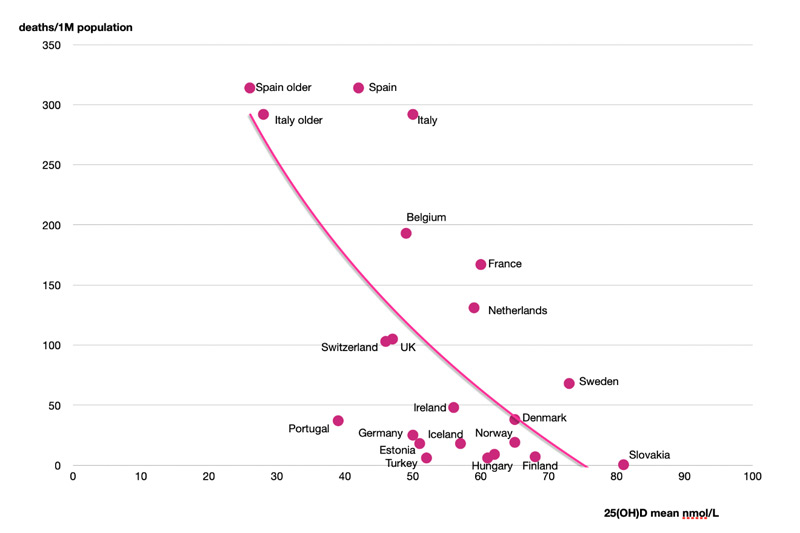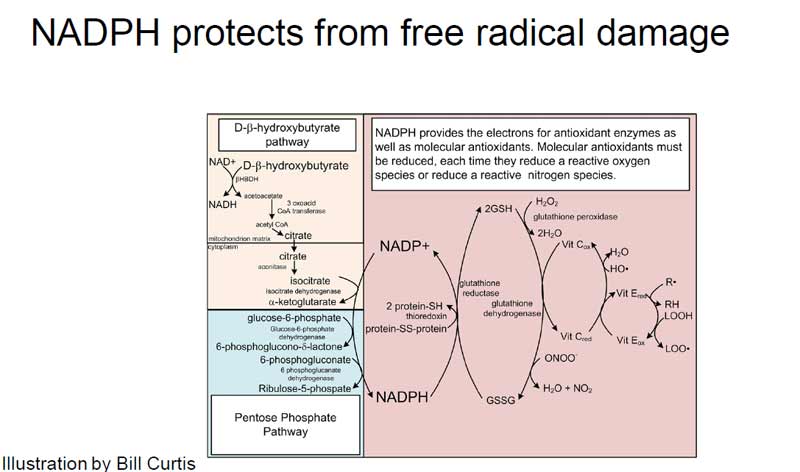In a June 22, 2020, Orthomolecular Medicine News Service press release,1 Damien Downing, president of the British Society for Ecological Medicine, outlines how we could resolve the COVID-19 pandemic in 30 days for about $2 per person, simply by taking affirmative action to raise vitamin D levels. The downside or risk of doing this is basically nil, while the potential gain could be avoiding another COVID-19 spike altogether.
“If we could arrange to give everyone vitamin D, and it failed to protect them, so what? The risk from not acting is much greater than the risk from acting,” Downing says, adding: “If you caught the COVID19 virus right now, having a good vitamin D status (from already having taken a supplement) would
Reduce your risk of the disease becoming severe by 90% Reduce your risk of dying by 96%
This is not ‘proven’ or ‘evidence-based’ until we have done controlled trials comparing it to placebo … But the data, already strong, has been pouring in since the start of the pandemic.”
Although the required prospective randomized controlled trials using vitamin D have not yet been completed, they are indeed underway and results from many will be in before year’s end. You can visit the clinical trials registry to review the current state of these trials.2,3 As of June 2020, there were over 20 studies in progress on the use of vitamin D in COVID-19.
Vitamin D and COVID-19
Downing goes on to cite research and supporting data. Among them is a study4 from the Philippines, which found that for each standard deviation increase in serum vitamin D, the odds of experiencing only mild disease rather than severe illness was 7.94 times greater, and the odds of having a mild clinical outcome rather than a critical outcome was 19.61 times greater. According to the author:
“The results suggest that an increase in serum 25(OH)D level in the body could either improve clinical outcomes or mitigate worst (severe to critical) outcomes, while a decrease in serum 25(OH)D level in the body could worsen clinical outcomes of COVID-2019 patients.”
Another study5 from Indonesia, which looked at data from 780 COVID-19 patients, found those with a vitamin D level between 20 ng/mL (50 nmol/L) and 30 ng/mL (75 nmol/L) had a sevenfold higher risk of death than those with a level above 30 ng/mL. Having a level below 20 ng/mL was associated with a 12 times higher risk of death. As noted by Downing:6
“With a deficient vitamin D status (<50nmol/L) the mortality rate from COVID-19 was 98.8% against 4.1% with adequate vitamin D (>75nmol/L). The Hazard Ratio is 24.1 … A Hazard Ratio of 4 means that in one condition, for instance vitamin D deficiency, you are 4 times more likely to suffer the ‘hazard’ than in another condition, say vitamin D adequacy.”
A third paper,7 which provides data from 20 European countries, also found that “the probability of developing COVID-19, and of dying from it, is negatively correlated with mean population vitamin D status, with both probabilities reaching zero above about 75 nmol/L,” (30 ng/mL) Downing notes.8
A vitamin D3 blood level of at least 75 nmol/L (30 ng/ml) is needed for protection against COVID-19.
In their preprint submission of this paper,9 the authors concluded, “We believe that we can advise vitamin D supplementation to protect against SARS-CoV2 infection.” Downing created the following graph10 to illustrate the data in that paper.
 Vitamin D Level Above 30 ng/mL Protects You Against COVID-19
Vitamin D Level Above 30 ng/mL Protects You Against COVID-19
Downing also addresses the issue of dosage and safety, highlighting how warnings about “excessive vitamin D intakes” being dangerous are very misleading and unwarranted, as toxicity has not been demonstrated until you hit blood levels above 200 ng/mL (500 nmol/L).
The recommended blood level for optimal health is currently between 60 ng/mL (150 nmol/L) and 80 ng/mL (200 nmol/L). In other words, there’s a significant margin of safety, even if you manage to exceed the optimal range.
“The three papers11,12,13 mentioned above show that a vitamin D3 blood level of at least 75 nmol/L (30 ng/ml) is needed for protection against COVID-19,” Downing writes.14
“Government recommendations for vitamin D intake — 400 IU/day for the UK and 600 IU/day for the USA (800 IU for >70 years) and the EU — are based primarily on bone health. This is woefully inadequate in the pandemic context.
An adult will need to take 4,000 IU/day of vitamin D3 for three months to reliably achieve a 75 nmol/L level.15 Persons of color may need twice as much.16 These doses can reduce the risk of infection, but are not for treatment of an acute viral infection.
And since vitamin D is fat-soluble and its level in the body rises slowly, for those with a deficiency, taking an initial dose of 5-fold the normal dose (20,000 IU/day) for two weeks can help to raise the level up to an adequate level to lower infection risk.”
Become Metabolically Flexible and Insulin Sensitive
As discussed in my interview with Dave Asprey, featured in “How Ketones May Be Useful Against COVID-19,” being metabolically flexible is another important lifestyle component. The reason for this is because insulin resistance makes you more susceptible to cytokine storm, a primary cause of death among COVID-19 patients.
The single most important step you can take to attain metabolic flexibility is to cut down the hours during which you eat. More than 90% of people eat for more than 12 hours a day, and more than half eat for more than 16 hours a day. The key is to reduce your eating window to six to eight hours, making sure the last food you eat is at least three hours before you go to bed.
When you restrict your eating window you will decrease insulin resistance, become more metabolically flexible and able to seamlessly switch back and forth between burning fat or carbs as your primary fuel. I wrote an entire book on how to become metabolically flexible, “Fat for Fuel,” but a simple summary is as follows:
Time-restrict your eating window to six to eight hours Eliminate all industrially processed vegetable oils Limit carbs to 50 grams a day until metabolically flexible and then increase to 150 grams of healthy carbs twice a week
This strategy is absolutely vital in light of the prevalence of insulin resistance. Over 90% of the U.S. is vitamin D deficient; 90% of the population is also insulin resistant. Research17 published in Metabolic Syndrome and Related Disorders in February 2019 concluded that 87.8% of the U.S. adults sampled were metabolically inflexible, which means they cannot efficiently burn fat for fuel.
Ketones May Also Be Useful Against COVID-19
When you are insulin sensitive, metabolically flexible and eating a cyclical low-carb diet, you will be able to generate healthy ketone levels. Remember that constant ketosis and low-carb is an unhealthy strategy. It is fine to go low-carb for a few months, but for optimal health you need to cycle healthy carbs back in once or twice a week, ideally when you are doing your hardest exercise or resistance training of the week.
When you burn sugar for fuel, you need to break glucose down to two molecules of 3 carbon pyruvate. Pyruvate is then used by your mitochondria after it is converted to acetyl CoA. Insulin resistance, in turn, can impair the enzyme that converts a breakdown product of glucose into pyruvate so it can be shuttled and burned as energy in your mitochondria.
The problem with COVID-19 is that the cytokine storm inhibits the enzyme converting pyruvate to acetyl CoA, which radically limits your mitochondrial ATP production. An additional consequence of this is that it also reduces NADPH.
NADPH is the battery of your cell, the reservoir of electrons that actually cause endogenous antioxidants like glutathione, vitamin E and C to be recharged so they can continue to work and mitigate against the free radical damage resulting from all this oxidative stress. One way to compensate is to make sure you have enough NADPH, and ketones radically upregulate NADPH.

NADPH also turns off NLRP3 inflammasome that produces cytokines like TNF alpha, NF Kappa B, IL1B, IL6 and IL18 (interleukins) that are causing all the damage.

All of that said, it’s important to realize that ketone esters will not treat the primary cause of the disease, which is an impaired immune system, typically due to insulin resistance. Ketone esters can, however, be used acutely, as they’ve been shown to provide rapid improvement in some patients with COVID-19. For an illustration of this, see the video above.
To address insulin resistance and metabolic inflexibility in the long term, your best bet is to implement a cyclical ketogenic diet, described in my book “Fat for Fuel,” as well as many previous articles that you can find by using the search bar on my site.
Molecular Hydrogen
Molecular hydrogen (H2 gas) has powerful antioxidant and anti-inflammatory effects,18 making it useful for COVID-19 by reducing inflammatory cytokines, as explained in this video by Tyler W. LeBaron, founder of the science-based nonprofit Molecular Hydrogen Institute.
In his video, LeBaron reviews the pathophysiology of COVID-19 and explains why H2 is being clinically investigated by discussing the proposed mechanisms of how molecular hydrogen might ameliorate this particular disease.
Molecular hydrogen or H2 has the ability to activate the Nrf2/keap1 pathway, thereby replenishing your endogenous antioxidants. In so doing, H2 helps regulate and maintain homeostasis in the whole system, preventing the infection from getting out of control and causing cell death.
Hydrogen can also downregulate NOX and NOS enzymes, thus lowering superoxide and nitric oxide production respectively. This is good, as when these two molecules are increased too much they instantly combine to create the pernicious peroxynitrite molecule. H2 also supports your mitochondrial function. Importantly, H2 selectively reduces peroxynitrites and hydroxyl radicals.
H2 also steps in to prevent a cytokine storm from occurring. For a written summary of LeBaron’s video lecture, see “How Molecular Hydrogen Can Help Against COVID-19.” H2 will also help improve NADPH, and works synergistically with time-restricted eating and cyclical ketosis.
Quercetin Plus Zinc May Lower COVID-19 Risk Further
In addition to vitamin D optimization, quercetin — which acts similarly to the drug hydroxychloroquine — and zinc19 may further lower your risk of COVID-19. Compelling evidence suggests the reason hydroxychloroquine appears so useful in the treatment of COVID-19 is a zinc ionophore, meaning it improves zinc uptake into the cell.
Quercetin has the same effect. In fact, one study20 has suggested the biological actions — which include antiviral effects — of quercetin may in fact be related to its ability to increase cellular zinc uptake.
Zinc is vital for healthy immune function21 and a combination of zinc with a zinc ionophore (zinc transport molecule) was in 2010 shown to inhibit SARS coronavirus in vitro. In cell culture, it also blocked viral replication within minutes.22 Conversely, zinc deficiency has been shown to impair immune function.23 As noted in a 2013 paper on zinc deficiency:24
“Zinc is a second messenger of immune cells, and intracellular free zinc in these cells participate in signaling events. Zinc … is very effective in decreasing the incidence of infection in the elderly. Zinc not only modulates cell-mediated immunity but is also an antioxidant and anti-inflammatory agent.”
The problem is that zinc is largely insoluble and cannot easily enter through the fatty wall of your cells. Getting all the way into the cell is crucial, as this is where the viral replication occurs. This is where zinc ionophores such as quercetin come in.
Quercetin is also a potent antiviral in its own right, and has the added advantage of inhibiting the 3CL protease25 — an enzyme used by SARS coronaviruses to infect healthy cells.26 According to one 2020 study,27 the ability of quercetin to inhibit SARS coronaviruses “is presumed to be directly linked to suppress the activity of SARS-CoV 3CLpro in some cases.”
To this you could also add niacin (vitamin B6) and selenium, as both play a role in the absorption and bioavailability of zinc in the body. For example, a study28 published in 1991 demonstrated that when young women were on a vitamin B6-deficient diet, their serum zinc declined, suggesting B6 deficiency affected zinc metabolism such that “absorbed zinc was not available for utilization.”
A more in-depth exploration and explanation of both niacin and selenium’s relationship to zinc is provided in the 2008 paper, “Zinc, Metallothioneins and Longevity: Interrelationships With Niacin and Selenium.”29
The MATH Protocol
If you are hospitalized with COVID-19, early treatment becomes paramount. While there’s a great deal of controversy over which treatment is best, clinical evidence clearly suggests mechanical ventilation should be avoided at all costs. I discussed the reasons for this in “Ventilators May Increase Risk of Death From COVID-19.”
Furthermore, while hydroxychloroquine combined with zinc appears effective, I believe one of the best treatments suggested so far is the MATH+ Protocol. The protocol was developed by the Front Line COVID-19 Critical Care Working Group,30 which includes Dr. Paul Marik, chief of the Division of Pulmonary & Critical Care Medicine at Eastern Virginia Medical School Norfolk, and boasts a near-100% effectiveness rate.
The MATH+ Protocol is designed to treat the second phase of COVID-19 infection — the stage when the hyperinflammatory immune response sets in. For best results, it must be administered early enough, though. The MATH+ protocol31 calls for the use of the following three medicines, all of which need to be started within six hours of hospital admission:
Intravenous methylprednisolone, to suppress the immune system and prevent organ damage from cytokine storms — For mild hypoxia, 40 milligrams (mg) daily until off oxygen; moderate to severe illness, 80 mg bolus followed by 20 mg per day for seven days. On Day 8, switch to oral prednisone and taper down over the next six days. Intravenous ascorbic acid (vitamin C), to control inflammation and prevent the development of leaky blood vessels in the lungs — 3 grams/100 ml every six hours for up to seven days. Subcutaneous heparin (enoxaparin), to thin the blood and prevent blood clots — For mild to moderate illness, 40 mg to 60 mg daily until discharged.
Optional additions include thiamine, zinc and vitamin D. In addition to these medications, the protocol calls for high-flow nasal oxygen to avoid mechanical ventilation that can damage the lungs.
Together, this approach addresses the three core pathological processes seen in COVID-19, namely hyperinflammation, hypercoagulability of the blood, and hypoxia (shortness of breath due to low oxygenation).
COVID-19 Doesn’t Have to Remain a Crisis
Health experts are warning we’re likely to see a second wave of COVID-19 this fall. I believe the strategies reviewed in this article can go a long way toward minimizing fatalities.
The first thing I recommend everyone do is to optimize your vitamin D this summer. Again, the optimal blood level for health and disease prevention is between 60 ng/mL and 80 ng/mL. (In Europe, the measurements you’re looking for are 150 to 200 nmol/L and 100 nmol/L respectively.)
However, simply getting above 30 ng/mL (75 nmol/L) may dramatically reduce your risk of serious infection and death, and doing so is both easy and inexpensive. As stated by Downing, we could fix the COVID-19 pandemic in as little as 30 days simply by making sure everyone is taking vitamin D in sufficiently large doses.
More detailed information about how vitamin D works and why it’s so important against COVID-19 can be found in my Vitamin D Report. Download and share! You can also find a summary of the key steps you need to take to optimize your level in this previous vitamin D article. Here is the link to my comprehensive science report.
I want to thank those of you who read the above report and provided constructive feedback. I want you to know that I did read those suggestions. I had already planned on writing a short summary, but the responses were nearly universal in support of that.
So, when you click the button below, you will get the condensed report that you can send to your friends and family and get them on board with the Vitamin D Campaign, which not only can save many lives, but can help prevent the country from shutting down again and worsening our already damaged economy.
Taking quercetin and zinc is another preventive strategy worth remembering, as is the advice to implement cyclical nutritional ketosis to make sure you’re metabolically flexible and not insulin resistant. Again, you can do this by following three powerful strategies:
Time-restricted eating window of six to eight hours Eliminating all industrially processed vegetable oils Limiting carbs to 50 grams a day until metabolically flexible and then increasing to 150 grams of healthy carbs twice a week
More acutely, ketone esters may offer rapid relief of COVID-19-related symptoms such as shortness of breath, and the MATH+ Protocol, administered within six hours of hospitalization, could be a life saver.
While the Front Line COVID-19 Critical Care Working Group has been struggling to get the word out to doctors and hospitals, you could (at bare minimum) request your doctor contact them and urge them to implement the protocol should you or someone you love get ill and need hospitalization.
Read more: articles.mercola.com



















